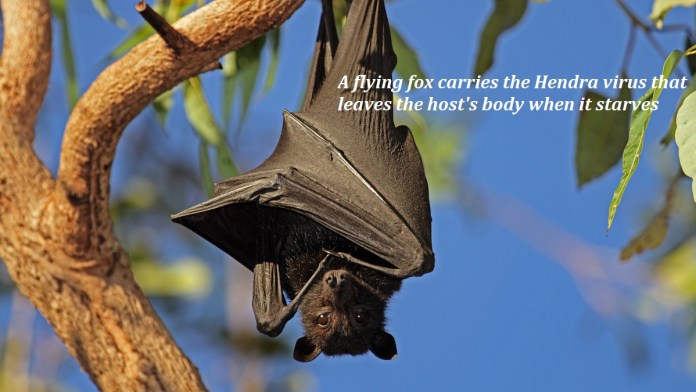The world is on the brink of the next pandemic and scientists are expressing apprehensions that the pandemic may be transmitted from hungry bats to humans. It is more likely that bats infect humans than that the infection is passed from another animal to humans. Researchers have made a discovery that could predict the timing of new outbreaks, a report in The Telegraph (the UK) says.
In a detailed study of a species of flying fox bats in Australia, experts found several ‘megabats’ with wingspans as large as three feet. When they were starving, they were releasing a lot of viruses from the body. More worryingly, the search for food has brought them into close proximity to humans and cattle. In such a situation, bat meat eaters like Chinese people can be the first to get infected and spread new infections around the world and thus a new epidemic can be reported.
The researchers used this combination to investigate how viruses can be transmitted from one species to another. This helped predict when the next pandemic is likely to occur. They also tried to find out whether the virus can be stopped even before the start of the pandemic.
The study focused on the Hendra virus, which causes a rare respiratory and neurological disease in bats. These flying mammals have a “supercharged” immune system that allows them to coexist with many dangerous pathogens, including the Nipah virus, Marburg and Sars-Cov-2.
But Hendra kills about 75% of infected horses. The symptoms of the disease are frothy nasal discharge, fever, difficulty in breathing, frantic drinking of water and willfully colliding with the walls of the stables.
This disease, first identified in Australia in 1994, can also infect humans. In the initial outbreak, two people were infected by horses — a stable worker who recovered and a 49-year-old horse trainer who succumbed to the virus. Since then, Hendra has crossed nearly 60 different species barriers to enter horses and infect seven humans, killing four.
Scientists in Australia and the US collected data on the disease over the past 25 years to better understand how it crossed the species barrier. In two landmark papers published in Nature & Ecology Letters, they found that Hendra outbreaks began after the starvation of bats.
Usually, the food of the nomadic flying fox is the nectar of eucalyptus flowers. When these flowers bloom, huge flocks of this species of bats make their camp on those trees. In the years in which there was no shortage of these flowers, no virus entered the body of horses or humans from bats.
Nutritionally stressed bats may cause the pandemic within 2 years
Deforestation and climate change mean that trees are producing fewer and fewer flowers. This has forced flying foxes to travel further into human-populated areas in search of food, where they come closer to horse roosts.
After sampling the bats, the researchers also found that they had significantly lower rates of Hendra virus, especially in winter climates that are more prone to outbreaks after nectar shortages. This is possible because hungry, free-ranging bats do not have the energy to mount an immune response that keeps the virus under control. “We can assume that in mammals, nutrient-stressed animals are less able to control viruses and therefore more likely to release viruses,” said Prof Raina Plowright, an infectious disease ecologist at Cornell University. He said this likely also applies to other bat viruses—including Nipah, a disease with a fatality rate of up to 70%.
Prof Plowright said, “Strategies that make sure that animals have enough to eat, have enough habit so they are not stressed and so they can move through their environment without having to overlap with humans, all contribute to reducing spillover risk.”
The scientists doing the research were able to make accurate predictions of their findings. According to him, the Hendra virus will start its regular journey from bat to horse within two years. The results of the research allowed scientists to allow health authorities to warn horse owners about the risks and ensure their animals are vaccinated.
Why pre-empting the possible pandemic has turned difficult
“In general, strategies that make sure that animals have enough to eat, have enough habit so they are not stressed and so they can move through their environment without having to overlap with humans, all contribute to reducing spillover risk,” Prof Plowright said. But she also cautioned that the ecology of disease rarely studies facts on the reservoir host. This is the story of the virus found in bats.
“We usually just focus on the virus, and usually only after it is spreading in the human population,” she said. “We rarely work backwards to figure out where the virus came from and why it emerged from a wild species into humans.
“If we understand the ecology of the reservoir hosts – the food they need at different times of the year and when that food is available or removed then we can study those times and places where all of the stressors align,” said Prof Plowright.
The findings turn out to be new details that could help scientists track the behaviour of Sars-Cov-2 before it enters humans.
At the One Health Congress in Singapore earlier this month, scientists outlined a new analysis that found some bat coronaviruses shared a common ancestor with SARS-CoV-2 as recently as 2016. In which fragments of the coronavirus genome were compared.
“We need to sequence the entire viral genome of these circulating bat viruses, not just tiny pieces of it [because they mutate and recombine constantly,” said evolutionary biologist Prof. Joel Wertheim of the University of California, San Diego, co-author of the research report. According to him, “If we don’t sequence small pieces of these bat virus genomes, we may miss the important bits that reveal the pre-history of Sars-CoV-2.”



You must log in to post a comment.